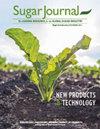弱阳离子稀汁软化厂稀汁pH值管理对浓汁色泽的影响
IF 0.3
4区 农林科学
Q4 Agricultural and Biological Sciences
引用次数: 0
摘要
在利用弱阳离子稀汁软化的甜菜糖厂中,利用在稀汁中添加纯碱来预软化汁至合适的饲料硬度,以供弱阳离子反应器使用。一般在弱阳离子反应器下游添加50%的苛性碱溶液,以抵消新再生弱阳离子树脂在反应器使用周期中H +渗出的影响。如果不能精确控制,反应后稀汁的再碱化可能导致稀汁的过度碱化,导致蒸发时pH值升高,蒸发过程中果汁的颜色也随之升高。本课题研究的目的是优化稀汁的预软化,同时也实现整体最佳pH管理,从而避免果汁过度碱化和在果汁浓缩过程中产生的加工果汁的相关颜色上升。开发并实施了一种既能满足预软化要求又能满足果汁整体碱化要求的预碱化控制方法,从而完全消除了反应器后再碱化使用液体苛性碱的情况,并消除了蒸发时色升过高的问题。确定了最小颜色上升浓度的最佳果汁pH值目标,从而在满足生产软稀果汁的竞争性果汁加工要求的同时,使果汁颜色和反相浓度最小。本文章由计算机程序翻译,如有差异,请以英文原文为准。
Influence of thin juice pH management on thick juice color in a factory utilizing weak cation thin juice softening
In beet sugar factories utilizing weak cation thin juice softening, soda ash addition to thin juice is utilized to pre-soften the juice to a suitable feed hardness for supply to the weak cation reactors. Generally, there is addition of 50% caustic solution downstream of the weak cation reactors to counter the effect of H + bleed from the freshly regenerated weak cation resin during the reactor service cycle. If not precisely controlled, the post-reactor re-alkalization of the thin juice may result in over-alkalization of thin juice leading to pH rise in evaporation and an associated color rise in the juice during evaporation. The subject investigation was undertaken for the purpose of optimizing the pre-softening of thin juice while also achieving overall optimum pH management thus avoiding juice over-alkalization and the resulting associated color rise in process juices during juice concentration. A means of pre-alkalization control was developed and implemented satisfying both the pre-softening and the overall juice alkalization requirements leading to the complete elimination of the use of liquid caustic for post-reactor re-alkalization and the elimination of excessive color rise in evaporation. Optimum juice pH targets for minimum color rise in concentration are identified resulting in minimum thick juice color and invert concentration while meeting the competing juice processing requirements for the production of soft thin juice.
求助全文
通过发布文献求助,成功后即可免费获取论文全文。
去求助
来源期刊

International Sugar Journal
工程技术-农艺学
自引率
33.30%
发文量
0
审稿时长
18-36 weeks
期刊介绍:
International Sugar Journal, first published in 1869, is a peer reviewed technical-trade journal focusing on latest developments in sugar technology and sugar industry. The journal embraces scientific and technical advances in agricultural production right through to the production of sugar crystal, as well as economic, trade and policy issues. Main topics include:
• sugarcane and sugar beet production
• front end operations
• cane and beet sugar manufacture
• sugar refining
• economics, trade and legislation and
• biorenewables (cogeneration, biofuels and biobased products)
Related topics, namely analysis, instrumentation, equipment and machinery, food and non-food uses of sugar and alternative sweeteners also form the focus of the journal.
 求助内容:
求助内容: 应助结果提醒方式:
应助结果提醒方式:


